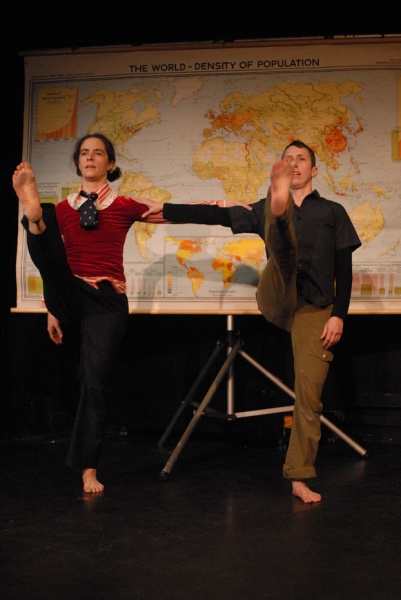Dance Week Is Killing Me: Rich Stuff
Lightsey Darst attended two Twin Cities Dance Week shows at the Bryant-Lake Bowl last week and found much to like.

“Dance week is killing me!” one of my friends exclaimed cheerfully last week. And understandably so, because Twin Cities Dance Week is about ten days of unrelated dance events, at maybe double the density of a typical stretch in the dance community, with double the guilt trip one usually feels for missing shows. I made it to two shows, both at the Bryant-Lake Bowl; all the rest fell into that golden Shangri-la of things unseen. Unlike more documentary dance-goers, I like to leave a few things unseen; it gives me the impression of riches still to come. But things seen are the present subject.
The dance scene showed its playful side at the six-choreographer dance-swap on April 29. Each choreographer wrote down instructions for a solo; the choreographers then drew lots from a hat and developed and performed the assigned solos. The instructions—varying from the imagistic to the explicit—were posted on the BLB theater wall for all to see, and the solos were broken up by bits of improv and the lively music of the Brass Messengers.
This project-oriented dance evening, with its transparency of process and light-hearted mood, tended in two directions: the game was either to transcend the distancing process and create something meaningful, connective, and personal; or to explode every last atom of the meaningful and create something utterly absurd. Or both at once: Laurie Van Wieren turned Judith Howard’s clippings on a striding cubist sculpture into “Platform,” a Tourettic journey from the front to the back door of the theater, each moment’s pose a separate and heroically achieved object.
Eva Mohn obeyed Suzanne Costello’s detailed instructions for “On the Saucers,” completely diving into the piece’s brittle hostess character; it helps that Mohn’s a charismatic actress as well as a sharp dancer, and can deliver lines like “I’m not very good at this—this thing” with verve.
Anna Marie Shogren’s “Don’t have calf muscles,” based on Van Wieren’s instructions, got the loudest laughs of the night. Shogren wears a certain expression of silly, blank-check conviction, which somehow makes everything that she does amusing, particularly when each movement is executed in task-fashion, without physical conviction. Shogren’s absurdity left me wondering what exactly I was laughing at; she milks the oddity of performance for all (and a little bit more than) it’s worth. The other three solos (performed by Pam Plagge, Suzanne Costello, and Judith Howard) were less successful, falling somewhere in between absurd project and personal creation. But since the entire evening had the loose feel of improv, nervy moments and eclectic touches were enough to keep the audience happy.
Morgan Thorson’s “Docudrama” (April 30-May 4) is entirely different from the playful free-for-all of the dance-swap. Thorson gives credit to the five performers for their assistance, but this 40-minute work in progress expresses one aesthetic vision. Like Mohn and Van Wieren, Thorson rides the line between ironic distance and expression, and no one moment is clearly on one side or the other.
Take the movement style of the piece: Thorson’s clean-lined ballet-inflected modern shades over into neurotic obsession (women banging their elbows on the floor as they continue to perform ballet arm gestures even after they’ve lost the space for the full gesture), but is at the same time beautiful. The women pose themselves in the partnered ballet dive known as a fish, in which the woman looks back over her shoulder at her partner; without partners, they smile brightly at nothing, while other women drag them offstage by their feet.
Costumes—brightly colored tights snugged down over dance sneakers, worn with smock tops—are silly 70’s retro, but they also reveal the dancers’ impeccably straight legs. Thorson plays with the BLB’s elaborate curtains, which is funny, but the all that ruffled black and red velvet also has the romance of a sweeping skirt, and the curtains slide open and closed on tableau vivant-like visions. “Docudrama” is some part Marie Antoinette, some part Charlie’s Angels, 70’s diet drugs, ice skater glam, sexy but pristine but silly, campy but icily classical but seductive. It’s lovely to see all these things in balance. Ironic distance is everyone’s bread and butter these days, but Thorson knows how to mix in beauty (conviction, truth, the absolute) to make a richer dish.